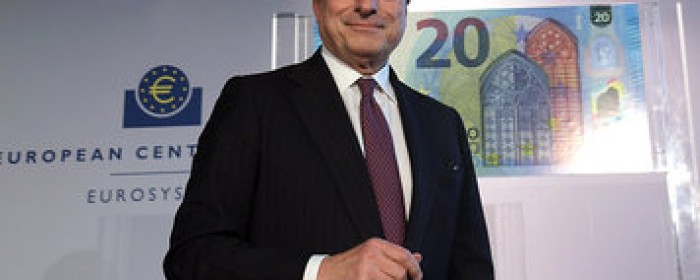Making good on his “whatever it takes” promise
I can see at least three clear and present dangers to the European Central Bank’s proposed quantitative easing program that’s scheduled to begin this month. The first has been widely discussed: that there aren’t enough government bonds available to fulfill the pledge to buy 1.1 trillion euros ($1.22 trillion) of debt at a pace of 60 billion euros per month. The second is wildly unpredictable: the prospect that the Greek government misbehaves badly enough that the future of the common currency is once again plunged into doubt. The third, though, is the real surprise: that the euro region economy might — might — be recovering sufficiently to make the bond-buying plan obsolete before it gets going in earnest.
I can see at least three clear and present dangers to the European Central Bank’s proposed quantitative easing program that’s scheduled to begin this month. The first has been widely discussed: that there aren’t enough government bonds available to fulfill the pledge to buy 1.1 trillion euros ($1.22 trillion) of debt at a pace of 60 billion euros per month. The second is wildly unpredictable: the prospect that the Greek government misbehaves badly enough that the future of the common currency is once again plunged into doubt. The third, though, is the real surprise: that the euro region economy might — might — be recovering sufficiently to make the bond-buying plan obsolete before it gets going in earnest.
The euro region economy is belatedly showing signs of rejuvenation, after eking out a 0.3 percent quarterly growth rate in the final three months of 2014. The volume of retail trade in the euro region climbed by 1.1 percent in January from December, and was up by 3.7 percent from a year earlier, according to figures released today by Eurostat, the EU statistics service. Those gains are also echoed in the wider EU region. While economic theory suggests the prospect of falling prices means shoppers will hold fire, anticipating better bargains in the future, the specter of deflation around the euro bloc doesn’t seem to be having the textbook effect:
 Source: Eurostat
Source: EurostatI’ll be as amazed as anyone if it turns out that the pessimistic outlook the bond market is anticipating turns out to be wrong. With the gap between 10-year borrowing costs in Germany and the U.S. at the widest in a quarter of a century (Treasuries yielding 2.1 percent and German bunds only 0.4 percent), investors are clearly saying they see an economic rebound in America, and the risk of a recession in euro land.
But the economic evidence in favor of a turnaround in the euro region is growing. In fact, economic data in the EU has consistently outpaced the expectations of economists for much of this year, based on an index compiled by Citigroup that tracks outcomes versus predictions:
Elsewhere, the Greece debacle continues to make investors nervous about the future of the common currency project. European Commission Vice President Valdis Dombrovskis said on Monday that the nation might need a third bailout by mid-year, given that it’s unlikely to be able to borrow directly from investors on the bond market. The Greek government insists it’s planning no such rescue, but walking the tightrope between keeping at least some of its anti-austerity promises while satisfying the fiscal stringency demanded by its lenders is proving tricky.
Sentix Asset Management in Germany holds a monthly survey on risks to the euro; the chances of a euro break-up surged to 38 percent in February, the highest since March 2013 when Cyprus was struggling to stay afloat:
If the euro shatters, there’s still no guarantee that the lack of contagion seen in recent months will be sustained. Cyprus and Portugal may be the next in line forced to leave the group, with Italy and Spain not far behind. It’s hard to see how the ECB could continue buying bonds of a nation whose membership was under threat; it’s easy to see a scenario where the German Bundesbank (which isn’t keen on QE anyway) demands a suspension of the program if the euro’s future composition was in doubt.
Finally, there’s the problem of sourcing bonds for the ECB to buy. Why would a bank sell its holdings to the central bank and pay for the privilege of having cash on deposit instead? Why would a pension fund that bought a five-year German bond in 2011 at a yield of 2.8 percent be willing to sell? It would pocket a profit on the price increase since then but face the prospect of putting its money into the same bond at a negative yield of minus 0.06 percent.
Combine that with insufficient supply of new bonds from governments whose borrowing needs aren’t as big as the ECB’s appetite to buy — according to Morgan Stanley, the ECB’s planned purchases will push the net issuance of euro government bonds into negative territory for the first time ever — and the ECB’s target of boosting its balance sheet by 1.1 trillion euros looks like a steep climb.
Here’s what Draghi said on Jan. 22 when he unveiled the planned bond purchases (emphasis mine):
They are intended to be carried out until the end September 2016 and will in any case be conducted until we see a sustained adjustment in the path of inflation which is consistent with our aim of achieving inflation at rates below but close to 2 percent over the medium term.
At the time, that looked very much like a lukewarm commitment to keep buying after the third quarter of 2016 if needed. I’m wondering, though, if Draghi’s ambivalence was more of a get-out-of-jail card that lets the program be ended prematurely should the ECB decide its work is done. After months of anticipation, don’t be surprised if you find yourself saying, “QE, we hardly knew ye.”
To read the entire article, go to http://bv.ms/1Gmjndh



















